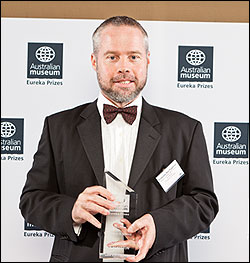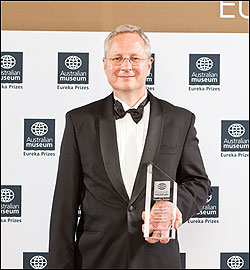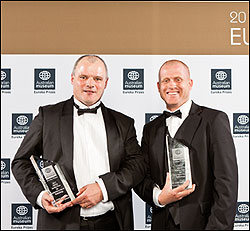
Photonics Researchers Win Eureka Prizes
Three photonics researchers were among 26 of Australia's top scientists, science educators and communicators to receive Australian Museum Eureka Prizes, considered the 'Oscars' of the Australian science world.
Seventy-nine finalists, competing for more than $250,000 in prize money, gathered at Sydney’s Hordern Pavilion on Sept. 6 for the annual awards ceremony.
Among the winners are scientists working on photonic chip technology, optical data communication, fiber optic catheters and more.
CRIRO Eureka Prize for Leadership in Science
Optical physicist Ben Eggleton, a professor of physics at the University of Sydney and founding director of the Australian Research Council's Centre of Excellence for Ultrahigh-Bandwidth Devices for Optical Systems (CUDOS), is developing a photonic chip that operates 1000 times faster than today’s electron equivalent. It has broken the world record for optical switching and is already contributing to new science and technology in areas ranging from energy-efficient communications and quantum information processing to environmental monitoring and astronomy.

Ben Eggleton, a professor of physics at the University of Sydney (Images: Australian Museum/247 Studios)
According to Eggleton and his team of more than 130 scientists, the prospect of terabyte-per-second processing will transform the way we manage everything from medicine and defense to education and international business. Eggleton won the 2011 Eureka Prize for Leadership in Science and $10,450 "for his leadership in establishing CUDOS and for the vast body of research he continues to contribute to the field," the Australian Museum said.
Eggleton's early career saw him establish important new principles in the field of optics and nonlinear wave physics while completing his PhD experiments at Lucent Technologies' Bell Laboratories. He became Lucent's youngest research director at the age of 30, and the fiber optic technology he developed there is now used in networks worldwide.
Google Eureka Prize for Innovation in Computer Science
In work that could revolutionize the way computer chips talk to each other, David Moss, associate professor in the School of Physics at the University of Sydney, developed a laser that allows light to be generated on silicon chips, which is critical in overcoming many energy and bandwidth bottlenecks for on-chip and chip-to-chip communications.
Moss and his team developed integrated multiple wavelength lasers on a chip that can be merged with CMOS technology. In simple terms, the laser produces ultrashort light pulses at record speeds to process and transmit information.

David Moss, associate professor from the School of Physics at the University of Sydney.
The technology can ultimately provide consumers with cheaper and faster computers. It can also help efforts to fight climate change because the optical technology uses far less energy than its electronic predecessor, museum officials said in awarding Moss the $10,450 Google Eureka Prize for Innovation in Computer Science. The prize is awarded to a team or individual for a computer science-related innovation that has the potential to improve the lives of many people.
ANSTO Eureka Prize for Innovative Use of Technology
Using an innovative fiber optic catheter, Dr. Philip Dinning of the Department of Human Physiology at Flinders University and Dr. John Arkwright of CSIRO Materials Science and Engineering have, for the first time, recorded pressures deep within the colon while the patient is fully mobile and conscious.
The inherent advantages of optical fiber, including its small diameter and high flexibility, have allowed the researchers to record pressures deep inside the gastrointestinal tract with high resolution over extended lengths of time while the patient is awake and moving. Their medical tool enables real-time monitoring of the human gastrointestinal tract.
Their studies have revealed that the previous best catheter technology may have missed or mislabelled up to 90 percent of backward and 40 percent of forward propagating pressure waves. These results from clinical trials have created their own waves within the gastrointestinal community, museum officials said, with global leaders lobbying the researchers to gain access to the technology, which they are currently licensing.

Dr. Philip Dinning, at the Department of Human Physiology at Flinders University and Dr. John Arkwright, of CSIRO Materials Science and Engineering.
While designed specifically for gastrointestinal use, the technology is garnering growing interest in the areas of urology and cardiology. It also has applications in infrastructure and hazardous environment monitoring, with the Austrialian government considering its use in water pipe monitoring.
The $10,450 Eureka Prize for Innovative Use of Technology is awarded to an Australian individual, group or organisation that has used new or existing technology in an innovative way that has significantly improved the outcome of their research. It is sponsored by the Australian Nuclear Science and Technology Organisation (ANSTO).
Other prizes were awarded for sea pansy-powered drug development, research questioning the ethics and effectiveness of whipping horses, and research into Tasmanian devil facial tumour disease, among others.
For more information, visit: www.australianmuseum.net.au/eureka
Published: September 2011